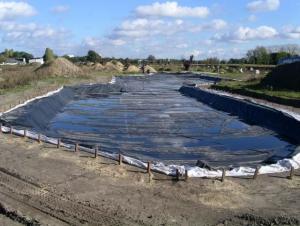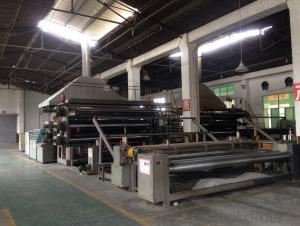4m wide EPDM pond liner weldable with good quality
- Loading Port:
- Qingdao
- Payment Terms:
- TT OR LC
- Min Order Qty:
- 1000 m²
- Supply Capability:
- 1000000 m²/month
OKorder Service Pledge
OKorder Financial Service
You Might Also Like
1. Introduction
| EPDM waterproof membrane is made from ternary ethylene-propylene
rubber, which is for waterproofing of exposed and non-exposed applications.
| EPDM waterproof membrane production adopts the world-advanced equipment of
cold feeding extrusion and continuous vulcanization technology.
| EPDM waterproof membrane is of high elasticity among high polymer waterproof materials
and becomes a world-popular waterproofing material.
2. Specification
1) Material: EPDM Rubber
2) Size: 1.2m/2m/3m/4m (width)*20m (length) or customized,
3) Thick: 1.2mm, 1.5mm, 2.0mm
4) Type: Weldable
5) Pattern: Non-reinforced (homogeneous)
6) Certificate: ISO9001/14001
3. Features
| Excellent physical and mechanical performance
| High tearing resistance
| Good deformation adaptability
| High puncture resistance
| High aging resistance
- Q:Is a waterproofing membrane breathable?
- No, a waterproofing membrane is generally not breathable as its primary purpose is to prevent water from passing through.
- Q:Can a waterproofing membrane be used for modular buildings or container homes?
- Indeed, modular buildings or container homes can benefit from the utilization of a waterproofing membrane. These types of structures pose distinctive obstacles in terms of waterproofing as a result of their modular design and the possibility of water seepage at joints and connections. By employing a waterproofing membrane, these vulnerable areas can be effectively sealed off, preventing any potential leaks or water-related harm. This versatile solution can be administered to the structure's exterior walls, roof, and foundation, delivering a robust and enduring barrier against water. Furthermore, a waterproofing membrane can be tailored to accommodate the specific needs of modular buildings and container homes, guaranteeing utmost defense against water infiltration.
- Q:Can a waterproofing membrane be used in areas with high humidity and moisture?
- Yes, a waterproofing membrane can be used in areas with high humidity and moisture. In fact, it is specifically designed to prevent water infiltration and protect the underlying structure from damage caused by moisture. Waterproofing membranes are commonly used in areas such as basements, bathrooms, and kitchens, where the presence of moisture and humidity is more pronounced. These membranes create a barrier that prevents water from seeping through walls, floors, or roofs, and they are typically made of materials like rubber, asphalt, or PVC. By installing a waterproofing membrane, you can effectively manage moisture levels and protect your property from potential water damage, mold growth, and other related issues.
- Q:Can a waterproofing membrane be used for foundation walls and footings?
- Yes, a waterproofing membrane can be used for foundation walls and footings. A waterproofing membrane is a thin layer of material, typically made of rubberized asphalt or polymer-modified bitumen, that is applied to the exterior surface of foundation walls and footings to prevent water penetration. It acts as a barrier, preventing water from seeping into the foundation and causing moisture-related issues such as dampness, mold, and structural damage. The waterproofing membrane is typically applied to the foundation walls and footings during the construction phase, either before or after the concrete is poured. It is important to ensure that the membrane is properly installed and sealed to provide effective waterproofing. The membrane is also commonly combined with other waterproofing techniques such as drainage systems and sump pumps to provide comprehensive protection against water intrusion. Using a waterproofing membrane for foundation walls and footings is a common practice in construction, especially in areas with high water tables or heavy rainfall. It is an effective and reliable method to prevent water damage and increase the longevity of the foundation. Properly waterproofing the foundation walls and footings is essential for maintaining a dry and structurally sound building.
- Q:Can a waterproofing membrane be used on gypsum board surfaces?
- Yes, a waterproofing membrane can be used on gypsum board surfaces. This membrane helps to protect the gypsum board from moisture, preventing water damage and increasing its lifespan.
- Q:Can a waterproofing membrane be used in basements?
- Basements can indeed benefit from the use of a waterproofing membrane. Utilizing a waterproofing membrane is highly recommended to safeguard against moisture infiltration and potential water harm. This membrane, a thin layer of material, can be applied to the external walls or floors of a basement to prevent water seepage. Its purpose is to act as a barrier, stopping water from entering the basement and maintaining a dry environment. This becomes particularly essential in regions with a high water table or prone to heavy rainfall or flooding. By implementing a waterproofing membrane, homeowners significantly decrease the risk of water damage, mold growth, and other problems associated with excessive moisture in the basement. It is important to emphasize that proper installation and maintenance of the waterproofing membrane are vital for its effectiveness and durability.
- Q:Is the foundation pit waterproofing and the foundation pouring on the working face?
- 2, your construction process is not clear: I tell you listen to the basic cushion after the completion of the construction, the cushion surface dryness to reach more than 90% can be done when the membrane waterproof layer, waterproofing membrane construction is completed, then do C20 40 ~ 50mm fine stone concrete protective layer, the construction is completed, generally the next day can be tied in the above bar.
- Q:Can waterproofing membranes be applied on roofs?
- Yes, waterproofing membranes can be applied on roofs. In fact, they are commonly used in the construction industry to provide an extra layer of protection against water infiltration. These membranes are typically made of synthetic materials such as PVC, TPO, or EPDM, which are highly resistant to water and can effectively prevent leaks and water damage on roofs. The application of waterproofing membranes on roofs is a proven method to enhance the longevity and durability of the roofing system, especially in areas prone to heavy rainfall or extreme weather conditions. Additionally, waterproofing membranes are flexible and can be easily installed on various types of roofing materials, including concrete, metal, or asphalt shingles. Therefore, if you want to ensure a watertight roof and protect your property from water-related issues, using waterproofing membranes is a reliable and effective solution.
- Q:Can waterproofing membranes be used on concrete planters?
- Concrete planters can indeed benefit from the use of waterproofing membranes. These membranes are specifically designed to create a strong barrier against water, effectively preventing any water from penetrating the concrete and causing harm. By applying a waterproofing membrane to a concrete planter, it guarantees that the planter will remain completely watertight, thus avoiding any potential leaks or damage to the surrounding area. This is particularly advantageous for planters located indoors or in areas where water leakage could lead to structural harm or messy situations. Moreover, waterproofing membranes also provide an additional advantage by safeguarding the concrete against freeze-thaw cycles, which can ultimately result in cracks and deterioration over time. Overall, the utilization of waterproofing membranes on concrete planters enables an extended lifespan and the preservation of their functionality for an extended duration.
- Q:Are there any specific installation techniques for corners and edges when using a waterproofing membrane?
- Using a waterproofing membrane requires specific techniques for installing corners and edges. These techniques are necessary to guarantee proper sealing and protection against water infiltration. For corners, it is advisable to utilize corner flashings or preformed corner pieces that are specially designed for waterproofing applications. These flashings or pieces are typically made of flexible materials like rubber or PVC. They should be placed over the membrane, securely fastened to the substrate, and overlapped with the membrane to create a continuous barrier against water. When dealing with edges, installing edge flashings is crucial to prevent water from seeping beneath the membrane. Edge flashings are installed along the perimeter of the waterproofing membrane and are usually made of the same material as the membrane itself. They should be firmly sealed and securely fastened to the substrate to ensure a tight and dependable seal. In addition, it is important to properly overlap the membrane at corners and edges to create a seamless and continuous barrier against water. It is necessary to carefully follow the manufacturer's instructions to determine the correct width and method of overlap. In general, a minimum overlap of at least 2 inches is recommended for corners and edges. Overall, the specific installation techniques for corners and edges when using a waterproofing membrane involve the use of corner and edge flashings, proper sealing and fastening, and correct overlap of the membrane. By adhering to these techniques, a reliable and effective waterproofing system can be achieved.
1. Manufacturer Overview |
|
|---|---|
| Location | |
| Year Established | |
| Annual Output Value | |
| Main Markets | |
| Company Certifications | |
2. Manufacturer Certificates |
|
|---|---|
| a) Certification Name | |
| Range | |
| Reference | |
| Validity Period | |
3. Manufacturer Capability |
|
|---|---|
| a)Trade Capacity | |
| Nearest Port | |
| Export Percentage | |
| No.of Employees in Trade Department | |
| Language Spoken: | |
| b)Factory Information | |
| Factory Size: | |
| No. of Production Lines | |
| Contract Manufacturing | |
| Product Price Range | |
Send your message to us
4m wide EPDM pond liner weldable with good quality
- Loading Port:
- Qingdao
- Payment Terms:
- TT OR LC
- Min Order Qty:
- 1000 m²
- Supply Capability:
- 1000000 m²/month
OKorder Service Pledge
OKorder Financial Service
Similar products
New products
Hot products
Hot Searches
Related keywords



























